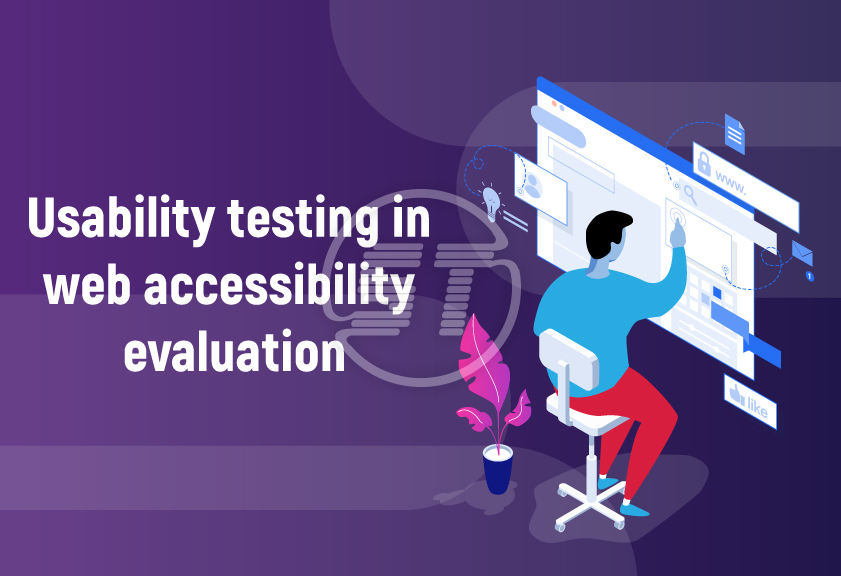Human potential is unmeasurable. However, society has its scale to measure physical and mental capabilities of people to perform a task and categorize them based on their judgement. Stephen Hawking, Helen Keller, and there is myriad other example of renowned personalities, suffered from some sort of disability. And they proved that disability cannot be a hinderance to follow one’s goals.
But people with disabilities require equal access to every available opportunity in order to outshine their capabilities. And since each facet of life is dependent on digital resources now, digital accessibility should be top priority for every website/application in order to provide accessible content/information to everyone.
Whenever a user with disability tries to access a website, it ought to offer a seamless experience to them. If the user is unable to read, hear, or understand the information, website’s usability is a point of concern. And to vanish this issue, organizations should perform usability testing thereby maximum users can access and utilize website’s information.
Usability testing – an inevitable part of digital accessibility!
As the name suggests, usability testing involves evaluating a website by testing it with real users. The goal is to identify usability issues, gather qualitative and quantitative data, and determine the level of user satisfaction. In the context of web accessibility, usability testing focuses on how easily users with disabilities can communicate with a website and complete desired tasks.
We know that a website ought to be designed and developed under web accessibility best practices, which implies that a website should be easy for everyone to understand, navigate, and interact with. Thus, usability testing protocols are made based on WCAG specifications.
The critical role of usability testing in web accessibility evaluation
- Identifying real-world accessibility issues.
- Gathering direct feedback form real-users and understanding their specific pain points.
- Validating compliance with accessibility standards.
- Enhancing user experience.
Best practices for usability testing in accessibility evaluation
Ideally, there must be a team of individuals with different disabilities to conduct usability testing. However, an accessibility expert can also perform the testing using feedback taken from real users with disabilities.
Also, testing website with commonly used assistive technologies is important, such as screen readers, magnifiers, and alternative input devices. This helps identify compatibility issues and ensures that the website is fully functional with these tools.
Though it cannot be one solution for all but in general, organizations adhere to below practices:
Plan thoroughly
Define clear objectives, select appropriate tasks, and choose a diverse participant group to take feedback from. Proper planning ensures that the testing process is effective and yields meaningful results.
Create an inclusive testing environment
Ensure that the testing environment is accessible and comfortable for all participants. Provide necessary accommodations, such as sign language interpreters or accessible testing software.
Analyze and act on findings
Carefully analyze the data collected during usability testing and prioritize issues based on their impact on users. Develop a plan to address these issues and implement changes to improve web accessibility.
Iterate and re-test
Accessibility is an ongoing process. Regularly conduct usability testing to identify new issues and ensure that previous improvements remain effective. Continuous testing and iteration help maintain a high level of accessibility.
When is usability testing required for an organization?
Usability testing is required in several key scenarios to ensure that a product, website, or application is user-friendly and meets the needs of its intended audience.
Below are some situations when usability testing is essential:
During development:
- Early prototypes: Testing early prototypes helps identify usability issues before they become ingrained in the final product.
- Iterative design: Regular testing throughout the development process allows for continuous improvement based on user feedback.
Pre-launch:
- Final testing: Before a product or website is launched, usability testing ensures that all components work as intended and that users can navigate and interact with the product effectively.
Post-launch:
- Real-world use: After launch, testing with real users in real-world conditions can reveal additional usability issues that were not apparent during development.
Redesigns and updates:
- Major changes: Significant updates or redesigns of a product or website should be accompanied by usability testing to ensure that new features or changes do not negatively impact user experience.
Performance monitoring:
- Ongoing feedback: Regular usability testing helps maintain a high standard of usability by addressing new issues that arise as users interact with the product over time.
Compliance and accessibility:
- Legal and standards compliance: Usability testing is critical for ensuring that a website meets legal and accessibility standards, such as those outlined in the ADA or WCAG.
Competitive analysis:
- Benchmarking: Comparing the usability of a product against competitors can help identify strengths and areas for improvements, providing a competitive edge.
User-centered design:
- User needs and preferences: Testing helps to align the website with user needs and preferences, ensuring it is intuitive and meets user expectations.
In a nutshell,
Usability testing helps creating a more inclusive and user-friendly web experience. Integrating usability testing into the accessibility evaluation process ensures that websites not only comply with technical standards but also meet the needs of all users, fostering a more inclusive digital world.
Please note that usability testing is mandatory for organizations to meet web accessibility requirements. Failure to comply with defined guidelines for user demographics can cost hefty penalizations of up to $75,000 to $150,000 approx.
Discover how user-friendly and accessible your website is with our free website accessibility scanner. A quick scan can provide valuable insights into usability barriers that impact accessibility for all users, including those with disabilities. Whether you're working to meet WCAG or ADA standards, this tool is an essential step in evaluating site’s accessibility. Start your free check today and take a meaningful step toward creating an inclusive online experience for everyone!


